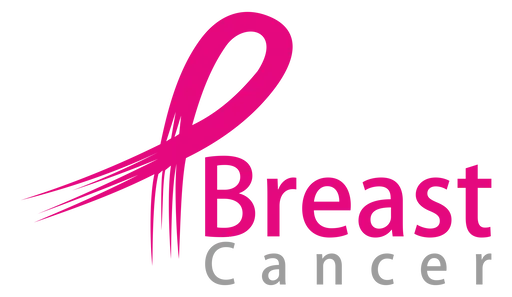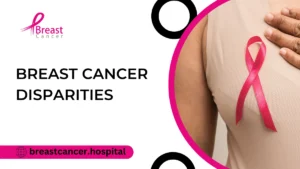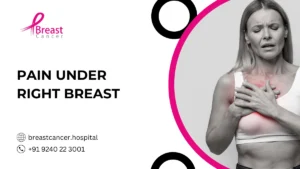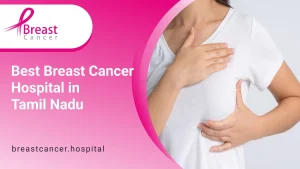Breast pain after delivery is a common concern for new mothers as their bodies transition into the postpartum phase. This discomfort can arise due to engorgement, hormonal fluctuations, or improper latching during breastfeeding. Additionally, conditions such as mastitis, blocked milk ducts, or nipple sensitivity can contribute to the pain. Many women also experience breast pain after pregnancy, which may persist for weeks or even months. Understanding the causes and remedies can help in managing this pain effectively. Whether it is breast pain after stopping breastfeeding or discomfort due to milk production, simple strategies such as warm compresses, proper breastfeeding techniques, and wearing a supportive bra can bring relief. By recognizing the symptoms and seeking timely treatment, new mothers can navigate this phase with greater comfort and confidence.
What Is Breast Pain?
Breast pain, also known as mastalgia, is discomfort or tenderness in one or both breasts. It can occur for various reasons, including hormonal changes, breastfeeding issues, or even unrelated factors like stress. While breast pain after pregnancy is usually linked to nursing, it’s important to monitor the pain to rule out other potential causes, such as clogged ducts or infections.
Breast pain may be:
- Cyclic pain: Often linked to hormonal changes, typically associated with menstruation.
- Non-cyclic pain: Localized pain caused by specific factors like injury or mastitis.
- Extramammary pain: Pain originating from areas outside the breast, like muscles or joints, but felt in the breast area.
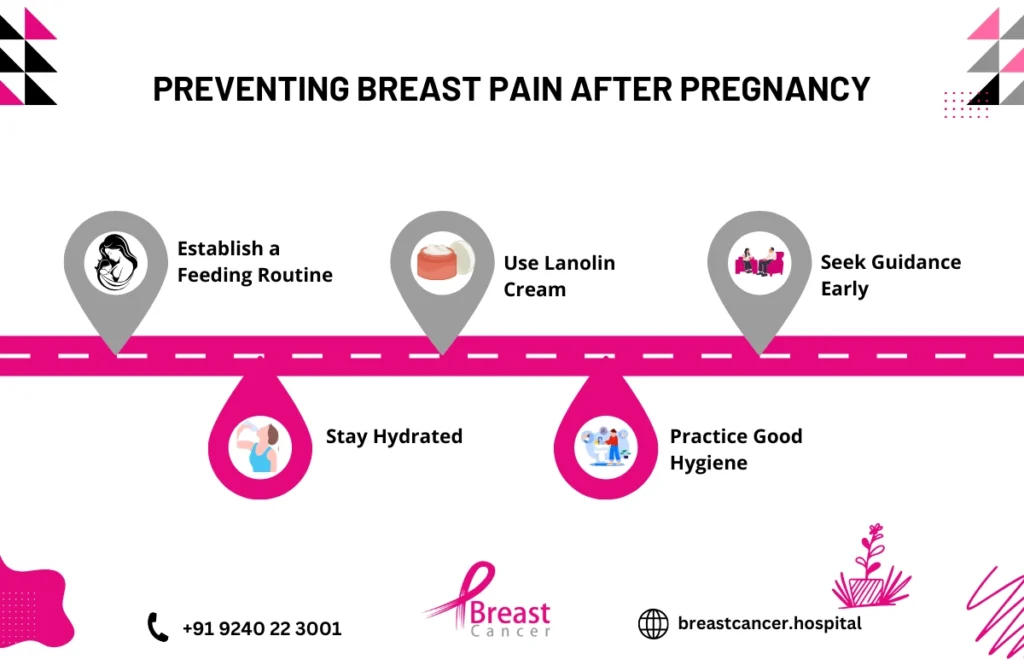
What Else Can Cause Breast Pain?
Several factors contribute to breast pain after delivery, including:
- Engorgement: Breasts become overly full and swollen when milk supply increases.
- Mastitis: An infection caused by blocked milk ducts can result in redness, swelling, and flu-like symptoms.
- Blocked Milk Ducts: A painful lump may form when milk is not fully drained.
- Hormonal Changes: Fluctuations in estrogen and progesterone can cause breast pain after pregnancy.
- Breast Pain After Stopping Breastfeeding: Milk production slows, leading to temporary discomfort.
If pain persists, it is essential to consult a doctor to rule out underlying conditions.
Types of Breast Pain After Pregnancy
1. Cyclic Pain
This type of pain is linked to hormonal shifts and is less common after pregnancy. However, if your menstrual cycle resumes while breastfeeding, hormonal fluctuations can cause tenderness.
2. Non-Cyclic Pain
Non-cyclic pain often results from physical causes like clogged milk ducts, engorgement, or mastitis. It’s typically localized to one area of the breast and may feel sharp or throbbing.
3. Left Side Breast Pain in Pregnancy
Left side breast pain in pregnancy or post-pregnancy can arise from engorgement, poor posture during nursing, or even heartburn. This specific discomfort can interfere with breastfeeding and daily activities.
What Else Can Cause Breast Pain?
Several factors contribute to breast pain after delivery, including:
- Engorgement: Breasts become overly full and swollen when milk supply increases.
- Mastitis: An infection caused by blocked milk ducts can result in redness, swelling, and flu-like symptoms.
- Blocked Milk Ducts: A painful lump may form when milk is not fully drained.
- Hormonal Changes: Fluctuations in estrogen and progesterone can cause breast pain after pregnancy.
- Breast Pain After Stopping Breastfeeding: Milk production slows, leading to temporary discomfort.
If pain persists, it is essential to consult a doctor to rule out underlying conditions
How Can I Ease Breast or Nipple Pain?
To relieve pain in breast after pregnancy, consider the following:
- Apply Warm Compresses: Warmth helps in milk flow and reduces swelling.
- Use Cold Packs: Reduces inflammation and numbs the area.
- Massage Gently: Helps unblock milk ducts and relieve discomfort.
- Wear a Supportive Bra: A well-fitted bra prevents unnecessary movement and offers support.
- Adjust Breastfeeding Position: A correct latch minimizes nipple pain and discomfort.
- Pain Relievers: Safe, doctor-approved medications can alleviate severe pain.
For mothers experiencing breast pain after stopping breastfeeding, gradual weaning instead of sudden cessation can prevent discomfort
Symptoms of Breast Pain After Pregnancy
Here are common symptoms to watch for:
- Swelling or tenderness in one or both breasts.
- Hard, painful lumps, especially in cases of clogged ducts.
- Redness or warmth in the breast area.
- Sharp or shooting pain while breastfeeding.
- Flu-like symptoms in cases of mastitis.
- Discomfort that persists even after breastfeeding sessions.
If you experience severe or prolonged pain, consult a healthcare provider to rule out conditions like breast cancer or other underlying health concerns.
How to Manage Breast Pain After Pregnancy
Managing breast pain after pregnancy involves proper care and preventive strategies. Here are some ways to reduce discomfort:
1. Apply Warm Compresses
- Before breastfeeding, use a warm compress to help milk flow.
- This can prevent clogged ducts and ease tenderness.
2. Massage the Breast
- Gently massage your breast in a circular motion toward the nipple.
- This can help release milk from blocked ducts.
3. Use Proper Nursing Positions
- Ensure your baby’s latch is correct to avoid additional strain on the breast.
- Experiment with positions to find what’s most comfortable for you.
4. Wear a Supportive Bra
- A well-fitted nursing bra can provide comfort and reduce strain on the breasts.
Preventing Breast Pain After Pregnancy
Prevention is better than cure, especially when it comes to the discomfort of breast pain after pregnancy. Here’s how you can minimize the likelihood of pain:
- Breastfeed Regularly: Avoid skipping feeding sessions to prevent engorgement.
- Check the Latch: Ensure your baby latches properly to reduce nipple pain.
- Stay Hydrated: Drink plenty of fluids to keep your milk supply flowing smoothly.
- Use Nipple Cream: Prevent cracking or soreness by applying a lanolin-based cream.
- Maintain Good Posture: Poor posture during breastfeeding can lead to left side breast pain in pregnancy and postpartum.
Is It Normal to Have Cramps While Breastfeeding?
Yes, cramping is common during breastfeeding. The release of oxytocin stimulates the uterus to contract, aiding in its return to pre-pregnancy size. This is called afterpains and is more pronounced in women who have had multiple pregnancies.
Cramps typically subside within a few weeks, but staying hydrated, using a heating pad, and taking mild pain relievers (if approved by a doctor) can help ease discomfort.
Is It Normal for My Breasts to Get Engorged?
Yes, breast engorgement happens when milk supply increases postpartum. It usually occurs 3-5 days after delivery and can lead to breast pain after delivery. Symptoms include:
- Swollen, firm, and tender breasts
- Warmth and slight redness
- Difficulty in latching due to tight skin
To prevent or relieve pain in breast after pregnancy, breastfeed frequently, express excess milk, and use cold packs to reduce swelling.
Is It Normal to Feel Pain During or After Breastfeeding?
Mild discomfort is normal initially, but ongoing pain may indicate:
- Improper Latch: Ensure the baby’s mouth covers most of the areola.
- Thrush: A fungal infection can cause burning pain.
- Nipple Vasospasm: Poor blood circulation can cause sharp pain.
If experiencing breast pain after stopping breastfeeding, it may be due to hormonal changes or residual milk buildup. Gradually reducing breastfeeding sessions can ease this discomfort.
Treatment Options for Breast Pain
For more persistent or severe cases of breast pain after pregnancy, medical treatment might be necessary:
- Antibiotics for Mastitis: If an infection is present, a doctor may prescribe antibiotics.
- Pain Relievers: Over-the-counter medications like ibuprofen can reduce inflammation.
- Surgical Drainage: In rare cases, an abscess caused by clogged ducts may need to be drained by a healthcare provider.
- Therapeutic Ultrasound: Helps treat severe cases of blocked ducts.
Always consult a healthcare provider before starting any treatment, especially if you suspect conditions like breast cancer.
Remedies for Left Side Breast Pain in Pregnancy
Experiencing left side breast pain in pregnancy can be particularly uncomfortable. Here are some effective remedies:
- Hot and Cold Therapy: Use a warm compress before feeding and a cold compress afterward.
- Gentle Stretching: Relieve muscle tension in your chest and shoulders.
- Switch Sides: Alternate breastfeeding positions to avoid overusing one side.
- Pain-Relief Gel Pads: These can soothe sore breasts and reduce inflammation.
Remedies for Extreme Breast Pain in Pregnancy
If you’re dealing with extreme breast pain in pregnancy, try these approaches:
- Consult a Lactation Specialist: They can help identify and correct any breastfeeding issues.
- Apply Cabbage Leaves: Chilled cabbage leaves can reduce swelling and pain.
- Avoid Tight Clothing: Restrictive bras or tops can worsen the pain.
- Rest: Ensure you’re getting enough rest to allow your body to recover.
How to Manage Left Side Breast Pain in Pregnancy
Managing left side breast pain in pregnancy requires targeted care:
- Check for Engorgement: Ensure your breast is not overly full, which can cause localized pain.
- Use Breastfeeding Pillows: Support your body during feeding to avoid straining muscles.
- Practice Relaxation Techniques: Deep breathing can help you cope with discomfort.
How to Manage Extreme Breast Pain in Pregnancy
To handle extreme breast pain in pregnancy, consider:
- Seek Medical Advice: If the pain is unbearable, consult your doctor to rule out infections or other issues.
- Ice Packs: Use ice packs wrapped in a cloth to reduce swelling.
- Frequent Feeding or Pumping: Empty your breasts regularly to prevent engorgement.
Conclusion
Experiencing breast pain after delivery is a natural part of the postpartum journey, but it doesn’t have to be overwhelming. Whether caused by engorgement, blocked ducts, or pain in breast after pregnancy, there are several effective ways to manage discomfort. Applying cold packs, adjusting breastfeeding positions, and gradually weaning can help alleviate breast pain after stopping breastfeeding. While mild pain is expected, persistent or severe discomfort should be addressed with a healthcare provider to rule out infections or complications. By staying informed and taking proactive steps, new mothers can ensure a more comfortable breastfeeding experience and an overall smoother postpartum recovery.
